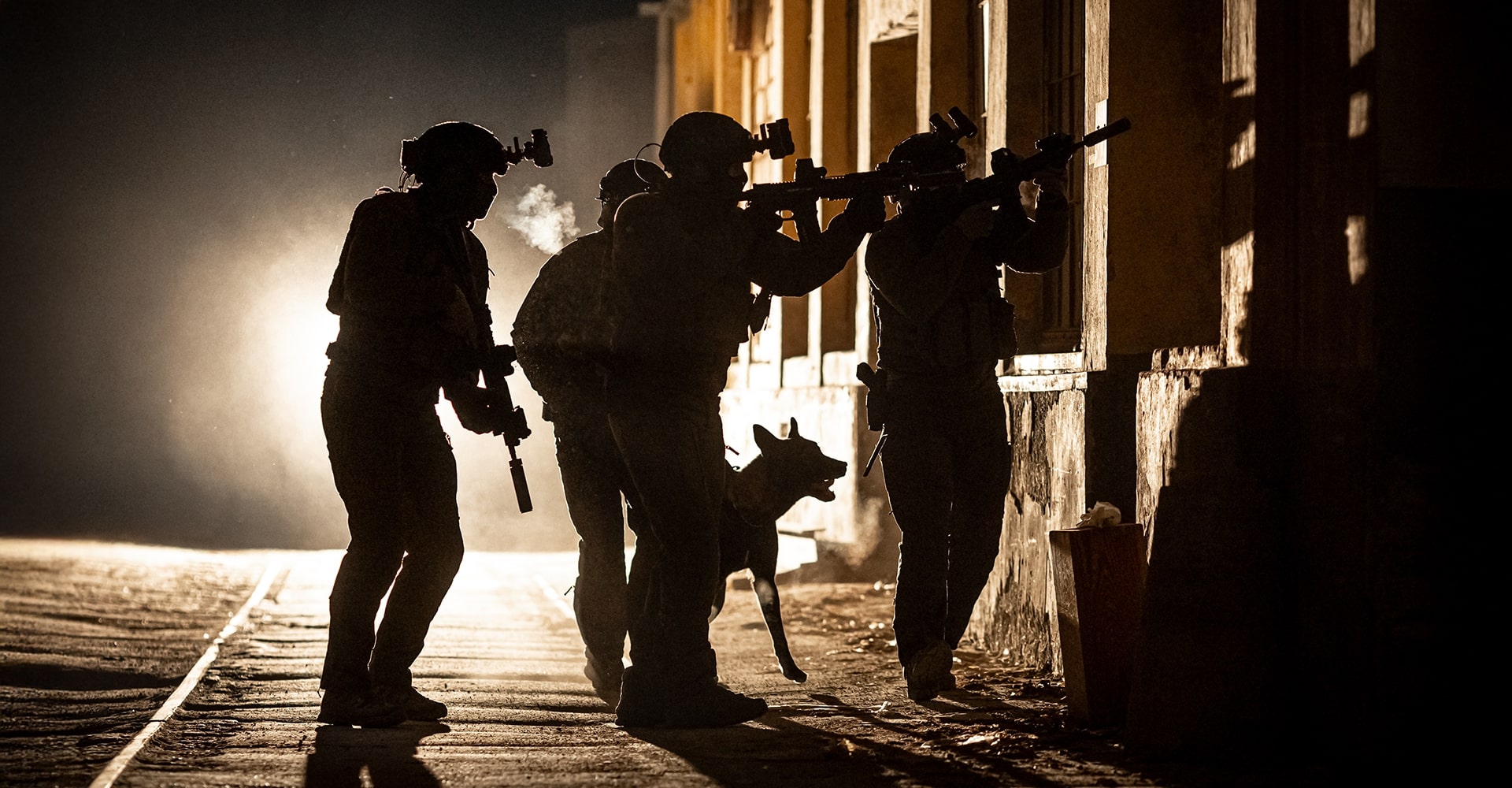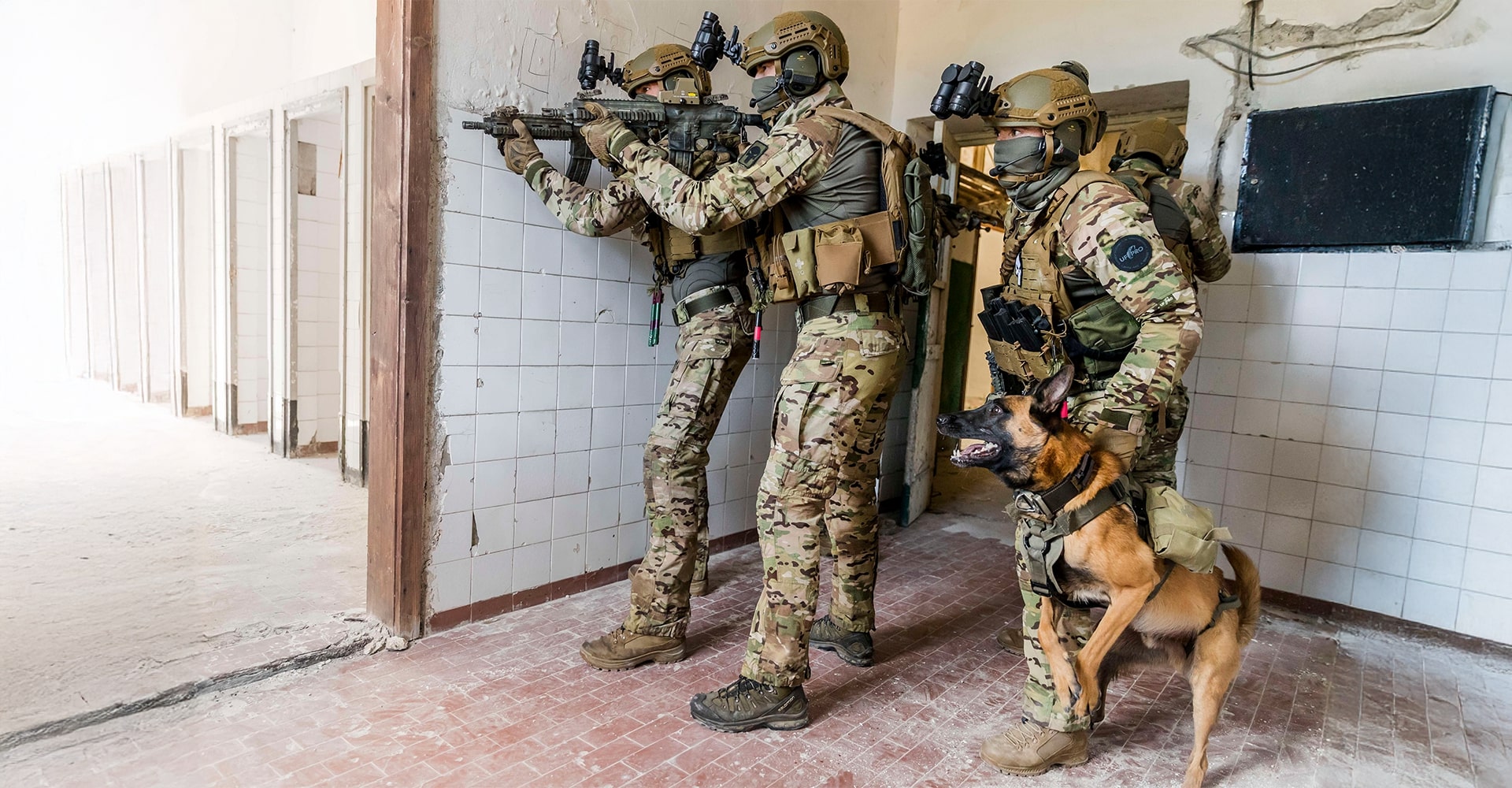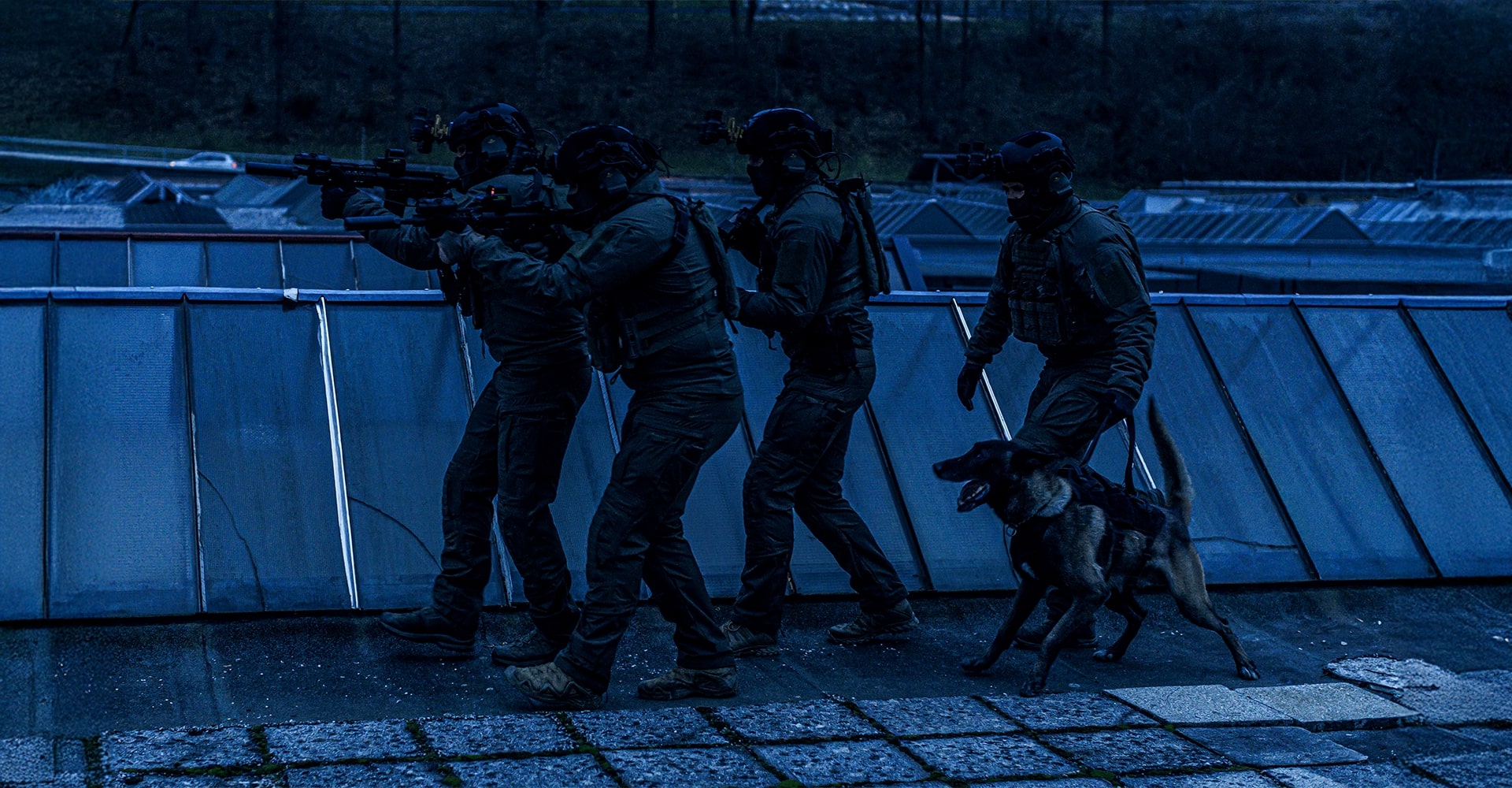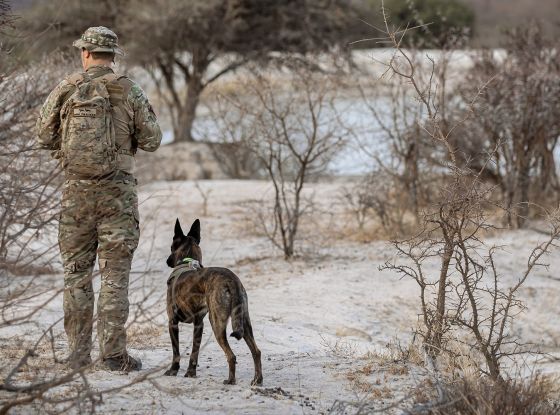When the trail goes cold, when footprints vanish, when the air itself feels empty, K9s are just getting started. They don’t just chase scent—they chase layers of smell, faint sounds, and fleeting movement that escape even the most alert human senses. They cut through terrain, silence, and deception—driven by instinct, sharpened by training, and backed by a handler who knows how to listen without saying a word.
In this blog post:
- How Can K9 Dogs Smell Trails in 3D?
- How Hearing Complements the K9’s Nose
- Do K9 Dogs Use Vision for Tactical Tracking?
- Colin’s Story: When Trust Becomes the Turning Point
- How Scent Age Affects Tactical Tracking in Different Terrains
- Why Technology Still Can’t Match a K9’s Nose
- The Handler–Dog Bond: Built on Trust, Strengthened by Care
- Conclusion
Drawing on insights shared by K9 expert Colin in our recent Beer:30 podcast episode, we’ll explore the extraordinary capabilities dogs bring to tactical tracking, particularly in anti-poaching missions, and reveal the invisible cues they pick up—through smell, hearing, and vision—that humans can only guess at. Listen to the whole podcast episode here: Tracking Poachers with K9s.
How Can K9 Dogs Smell Trails in 3D?
To humans, a scent might be something linear—a simple path from point A to point B. For dogs, it's something far more complex and three-dimensional. While dogs do not literally "see" odors, they perceive scent plumes spatially with extraordinary detail, effectively interpreting scents suspended in the air, clinging to surfaces, and lingering on objects. This spatial scent perception creates a dynamic “3D map” of their environment.
Dogs have up to 300 million olfactory receptors (compared to roughly six million in humans), and the olfactory bulb in their brain is about 40 times larger proportionally than ours. This massive processing power gives dogs a sense of smell tens of thousands of times more sensitive than that of a human—though the exact figure varies by scent type and breed. Certain breeds like Bloodhounds, Beagles, and German Shepherds are especially gifted, with heightened receptor counts and scent-tracking ability that makes them ideal for tactical operations.
With this advanced biological toolkit, dogs can:
- Distinguish older scents from fresher ones, effectively building a timeline of human activity.
- Detect scents carried by the wind, pinpointing direction and approximate distance.
- Interpret subtle environmental shifts—disturbed vegetation, residual odors—creating a dynamic, invisible map of recent activity.
- Pinpoint direction and distance based on scent density.

And scent doesn’t just tell them where someone went—it can also reveal how that person felt at the time.
Detecting Fear, Adrenaline, or Deception
Can K9 dogs smell fear? Yes—and even more. Dogs can do more than detect physical presence—they can sense emotion through biochemical markers. When humans experience stress, fear, or adrenaline surges, we release subtle chemicals like cortisol or epinephrine. To a dog, these shifts don’t go unnoticed. In tactical scenarios, this lets them:
- Identify suspects under pressure, even if they’re motionless or well-concealed.
- Distinguish locals moving calmly from those behaving nervously or erratically.
- Cut through deception, such as false trails or scent-masking techniques.

How Hearing Complements the K9’s Nose
While their sense of smell is their primary tracking tool, their hearing is incredibly sharp and plays a key role in situational awareness. Dogs can detect frequencies between 40 Hz and 60,000 Hz (compared to a human’s range of 20 Hz to 20,000 Hz) and can hear sounds from much farther away. That means:
- They can pick up faint movements (like footsteps or rustling) well before a human would.
- They may detect vocal cues or environmental sounds (like distant vehicles or wildlife disturbances) that signal something out of place.
- Their ears help them localize sounds with high precision—useful in patrols or when working off-leash.
In K9 operations, especially during ambush risk or low-visibility missions, hearing complements their nose—helping them detect, assess, and alert their handler to hidden threats.
SUBSCRIBE TO UNLOCK OUR EXCLUSIVE CONTENT
Enter your email and get timely updates and relevant intel on tactical topics directly to your inbox.
You are signing up to receive updates via e-mail from which you can opt out at any time. Visit our privacy policy for more info.
Do K9 Dogs Use Vision for Tactical Tracking?
Yes, but not in the way humans do. For K9s, tracking is scent-first, vision-second. Here's what we know:
What K9 Vision Is Like:
- Dogs see fewer colors than humans—mostly shades of blue and yellow.
- Their night vision is significantly better thanks to a structure called the tapetum lucidum, which reflects light and improves vision in low-light conditions.
- They have better motion detection, especially at a distance, but less visual acuity (their eyesight is more blurry compared to ours).
How They Use Vision While Tracking:
- Confirming scent cues visually (e.g., spotting disturbed terrain once they've followed a trail).
- Scanning for movement once they’ve narrowed down a location using scent.
- Reading handler body language, especially when off-leash or operating semi-autonomously.
- Navigating obstacles in their path as they track (essential in complex terrain).
Together with their acute hearing and powerful sense of smell, vision forms part of the multi-sensory toolkit that makes K9 dogs so effective in tactical operations.
In high-risk missions, this combination of scent, hearing, and vision allows K9 units to identify threats faster than their human counterparts can react. Watch how this plays out in action:
Colin’s Story: When Trust Becomes the Turning Point
Behind every tactical K9 is a handler who doesn’t just command—they listen. The bond between dog and handler is built over months of training, but it’s tested under pressure.
Colin recalled a vivid memory from a night operation in rugged terrain. His team walked 42.5 kilometers in just 13 hours, tracking suspected poachers with the help of their K9 unit. At one critical moment, the team decided to perform a 360° scent scan. The dog quickly locked onto a direction. For the next 200 to 300 meters, there were no visible signs—no broken vegetation, no footprints. The human eye saw nothing. But the dog remained focused.
![]()
And then it happened:
"After about 300 meters, I finally saw it—a smudge in the ground. That moment gave me chills. You trust your dog, you follow him in the dark, across kilometers of nothing, and suddenly—there it is. That smudge becomes your reward. It confirms everything you believed in."
Moments like this are not rare—they’re reminders that when technology or eyesight fail, the dog’s nose does not. And that the connection between handler and dog is more than operational—it’s instinctive, proven, and deeply personal.
Get a behind-the-scenes look at how an anti-poaching operation unfolds in the field and read more in the blog post: A Day in the Life of a K9 Dog Handler:
How Scent Age Affects Tactical Tracking in Different Terrains
A scent trail doesn’t simply fade with time—it evolves based on environmental conditions and terrain.
Open Terrain (Savannah, Grassland):
- Wind disperses scent faster.
- Dogs must rely on air-scenting, capturing particles from the breeze.
- Trails fade more quickly, requiring speed and sharp direction cues.
Closed Terrain (Jungles, Forests):
- Vegetation traps and preserves scent longer.
- Dogs focus on ground-scenting, interpreting slight disturbances.
- Conditions allow for slower, more meticulous tracking.
Understanding how dogs interpret scent differently in various environments helps handlers make faster, more informed tactical decisions.
Why Technology Still Can’t Match a K9’s Nose
Thermal cameras, drones, AI-powered sensors—they all contribute valuable tools to modern tracking. But in conditions where visibility is compromised or electronic systems falter, K9s excel. Here's why:
- Thermal imaging can identify heat signatures but fails when targets use natural concealment or camouflage techniques.
- Drones have limited endurance and are less effective under dense forest canopies.
- Electronic sensors and AI technologies are limited by terrain interference and mechanical failure.
Dogs, on the other hand, offer unmatched advantages:
- Constant recalibration to changing environmental conditions.
- Intuitive decision-making, guided by scent and experience.
- Emotional connection with handlers, enabling faster reaction and more fluid teamwork.
Their ability to remain operationally effective even under exhaustion, heat, or psychological pressure is something that machines still can’t rival.
The Handler–Dog Bond: Built on Trust, Strengthened by Care
Every movement a dog makes—slight head tilts, tail shifts, sniff patterns, even nose angles—carries meaning. Handlers learn to decode these micro-signals, turning scent interpretation into a shared language. In tactical tracking, particularly when visibility is limited and uncertainty is high, this relationship becomes essential to success.
As Colin’s experience shows, mutual trust isn’t a backup plan. It’s the strategy. It’s what keeps you moving forward when there’s nothing to see, only scent to follow. This bond isn’t built on commands alone. It’s forged through months of shared stress, silence, and repetition—and proven in the dark, when everything depends on the dog’s nose and the handler’s trust in it.
Just as vital is how these dogs are treated. K9s aren’t tools. They’re teammates. Their training is rooted in positive reinforcement. They receive rest, hydration, and proper post-mission care. Many handlers work with the same dog for years, deepening the communication, respect, and emotional connection essential for high-risk operations.
These practices ensure not only peak performance but long-term well-being. Because at the end of every mission, the goal remains the same: bring everyone home—two-legged and four-legged alike.

Conclusion
With unmatched sensory perception, real-time adaptability, and a unique ability to interpret invisible cues, K9 units remain irreplaceable in anti-poaching and tactical tracking efforts. As technology advances, the dog’s nose continues to lead—reminding us that the most advanced tracking system in the world might just be the one that wags its tail.



